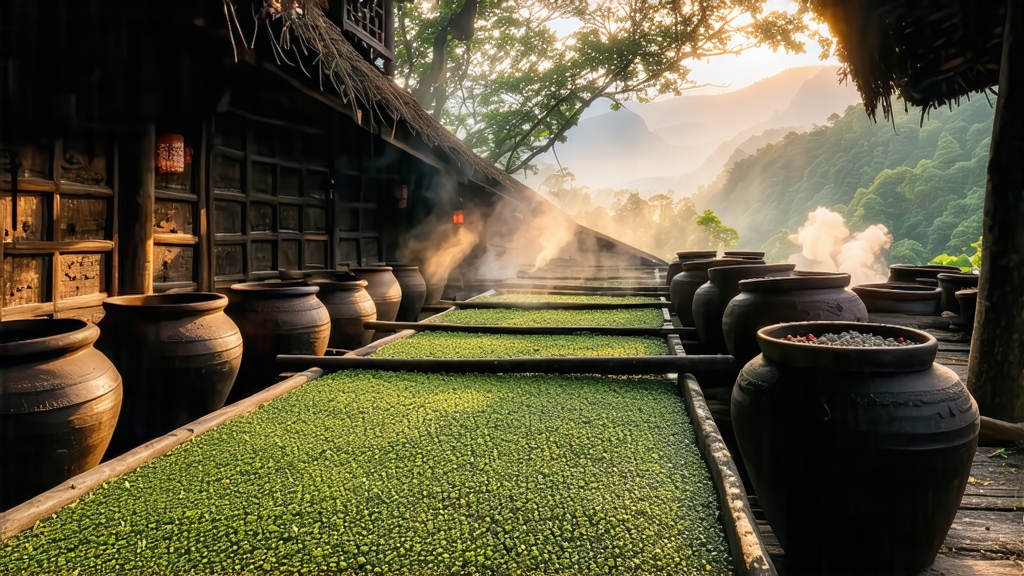
If every tea tells a story, Lapsang Souchong whispers the earliest chapter of black tea in a voice scented with pine and campfire. Originating in the Wuyi Mountains of northern Fujian around the mid-17th century, this leaf is universally acknowledged as the prototype of all black teas. Local legend claims that desperate farmers, rushing to dry freshly picked leaves before an advancing army, hastily smoked them over resinous pinewood. The accidental innovation yielded a crimson liquor so fragrant that Dutch traders christened it “bohea,” a corruption of “Wuyi,” and shipped it to Europe where it became the foundation of English Breakfast blends and the darling of the London coffee-house scene. Thus, Lapsang Souchong is not merely a tea; it is the ember from which the global passion for black tea first caught fire.
Geographically, authentic Lapsang Souchong can only be born in the 600–1,200 m elevation band inside Tongmu Guan, a protected enclave where subtropical mists cling to granite cliffs and the Min River carves narrow gorges. Here, the Xingcun Xiaozhong cultivar—small-leaf, slow-growing, and rich in polyphenols—absorbs volatiles from surrounding Masson pines and cedar, terroir that no other place can replicate. Two distinct styles now coexist. The traditional “Smoke-dried” version, called Zhengshan Xiaozhong, is withered over gentle pine embers, pan-fired, rolled, oxidized 80–90 %, then hot-smoked in wooden chambers above glowing pinewood logs. The newer “Unsmoked” or “Wuyi Black” bypasses the final smoking, showcasing instead cocoa, dried longan, and mineral notes prized by contemporary Chinese gongfu aficionados. Both share the same plucking standard: one bud, two leaves, harvested only between Qingming and Grain Rain when spring coolness concentrates amino acids.
Crafting Lapsang Souchong is a dialogue between human patience and pine resin chemistry. After plucking, the leaves are laid on bamboo trays inside a qinglou—an attic built over the smoking room—where ambient heat (30 °C) and pine smoke dehydrate 30 % of moisture in four hours. This unique withering imparts the first layer of smoky phenols. Rolling follows, breaking cell walls to release catechins and polyphenol oxidase; the bruised leaves rest in wooden barrels covered with wet cloth, oxidizing rapidly in the mountain humidity. When the leaf edge turns chestnut and the center remains olive, firing at 200 °C halts oxidation, locking in maltol and theaflavins. Finally, the crucial smoking phase: pinewood is burned without flame, generating a 60 °C smoke stream that drifts upward through mesh screens for six to eight hours. Masters gauge readiness by aroma alone: the leaf must smell neither raw nor tarry, but like toasted almond and resinous honey. The entire process spans 24 attentive hours, after which the tea is rested for thirty days so smoke and leaf marry in quiet darkness.
To brew Lapsang Souchong respectfully, treat it as you would a peated single-malt—water first, theatrics later. Pre-heat a thin-walled gaiwan or Yixing zi-sha pot with 100 °C water; use 5 g of leaf for 120 ml. Flush the leaves for three seconds, discarding the rinse to awaken the leaf and wash away surface tar. First infusion: 95 °C, 10 seconds. The liquor emerges a translucent amber ringed with a rose-gold halo; the nose is campfire, yes, but also dried apricot and cinnamon bark. Second infusion, 15 seconds, reveals a sweeter core—malt, cacao, a whisper of lychee. By the fifth infusion the smoke recedes, leaving a clean slate finish reminiscent of Wuyi mineral springs. Western-style drinkers may steep 3 g per 300 ml for three minutes, but expect a brasher, more tar-forward cup; milk softens the edges yet obscures the subtle fruit notes that gongfu brewing coaxes.
Tasting notes are best mapped on a spider chart: smoke, resin, dried fruit, floral top, mineral base. High-grade Zhengshan Xiaozhong balances these five vectors